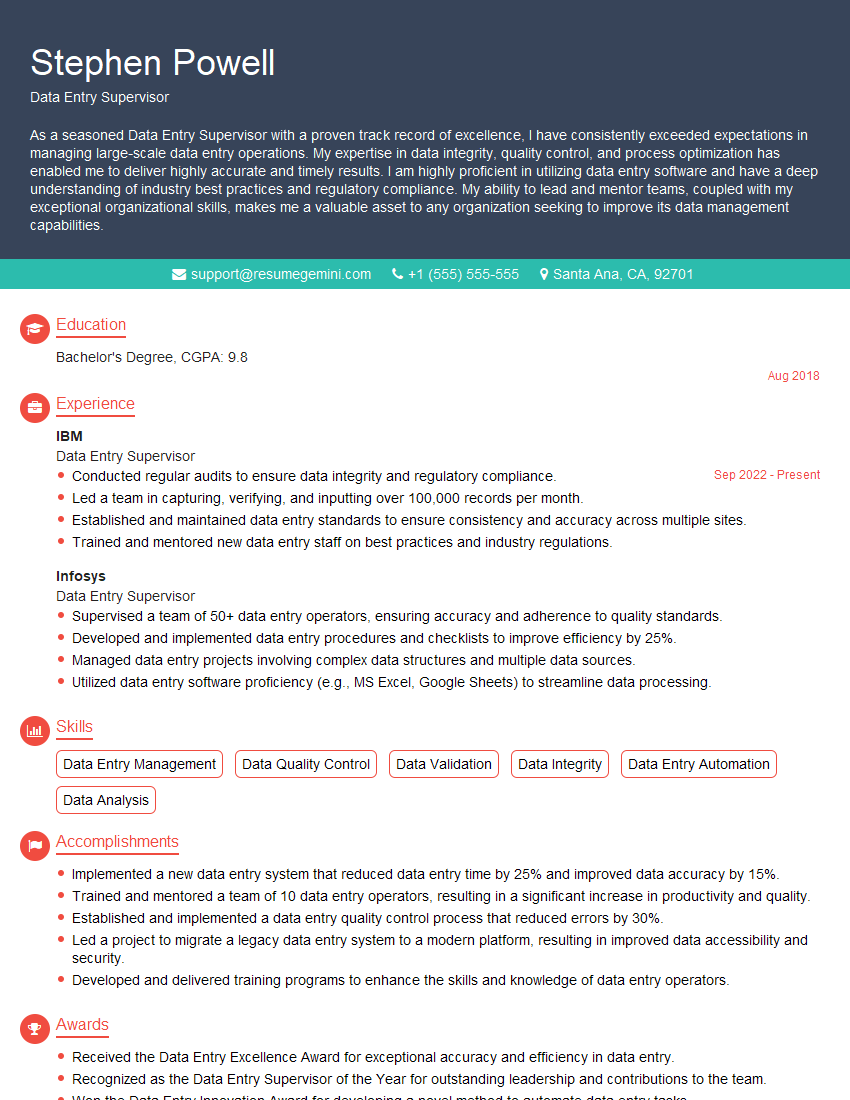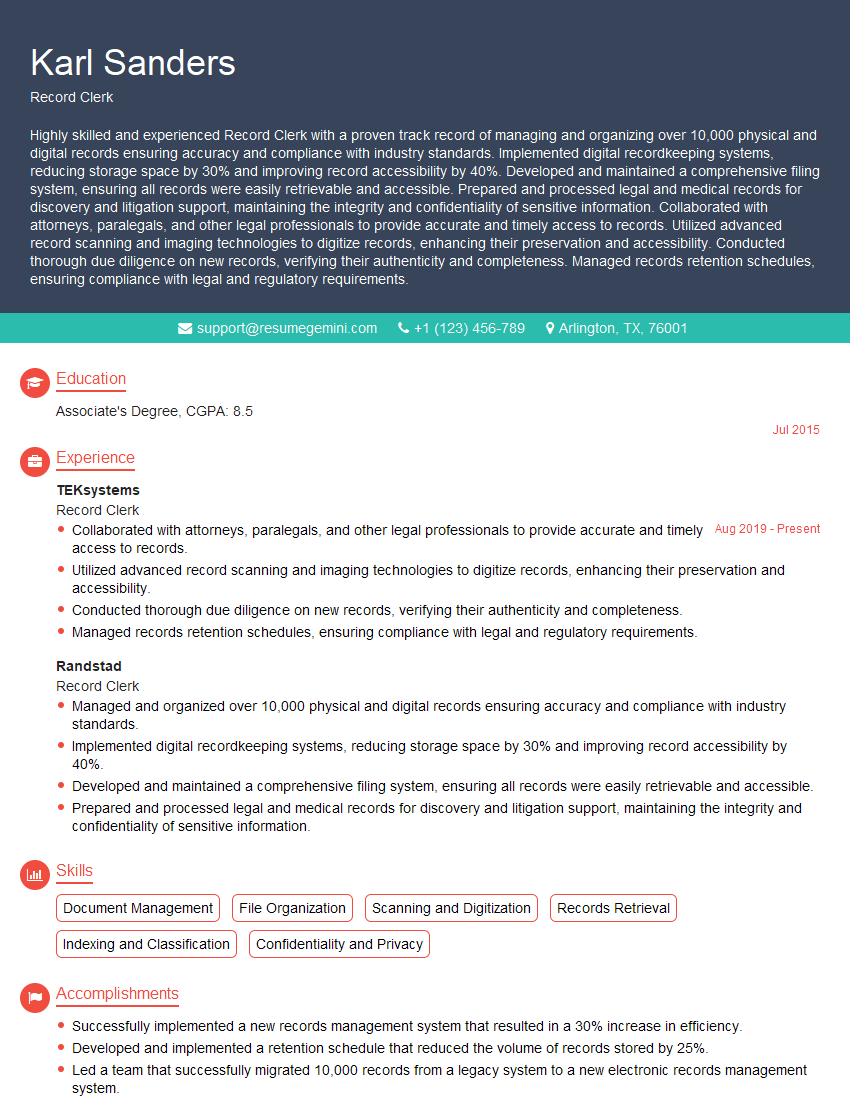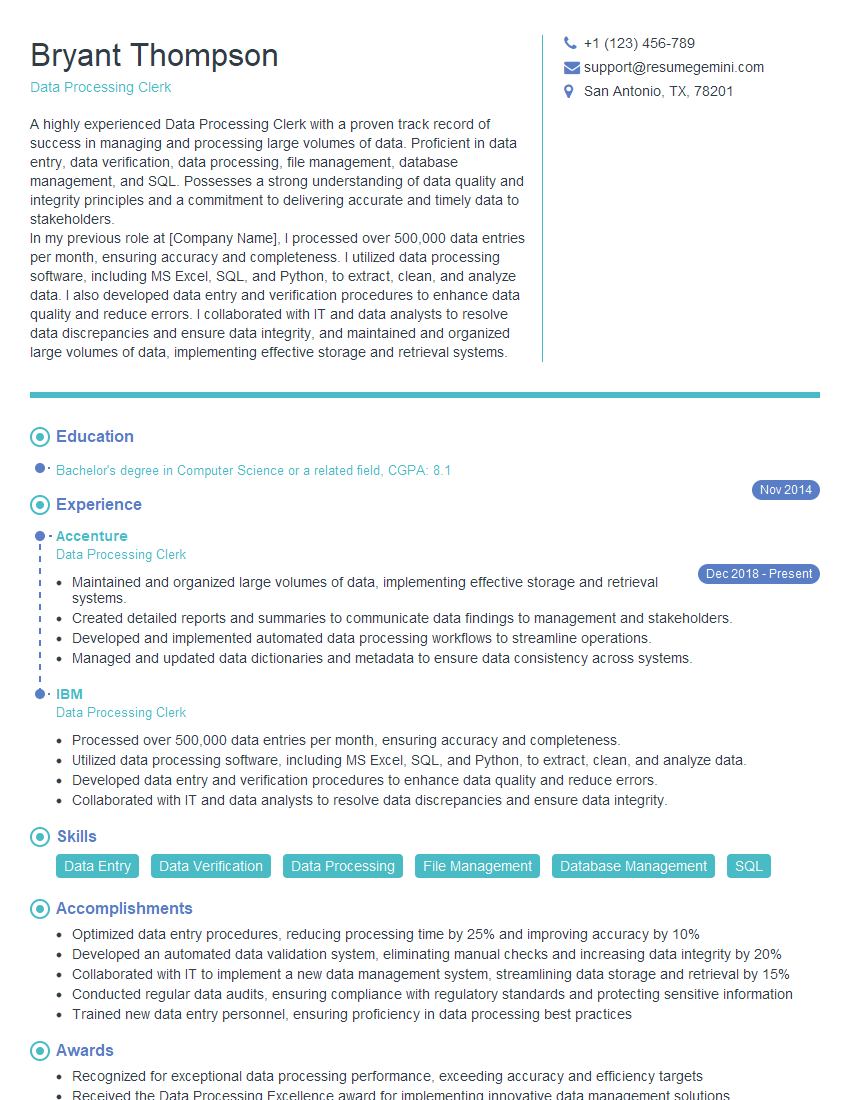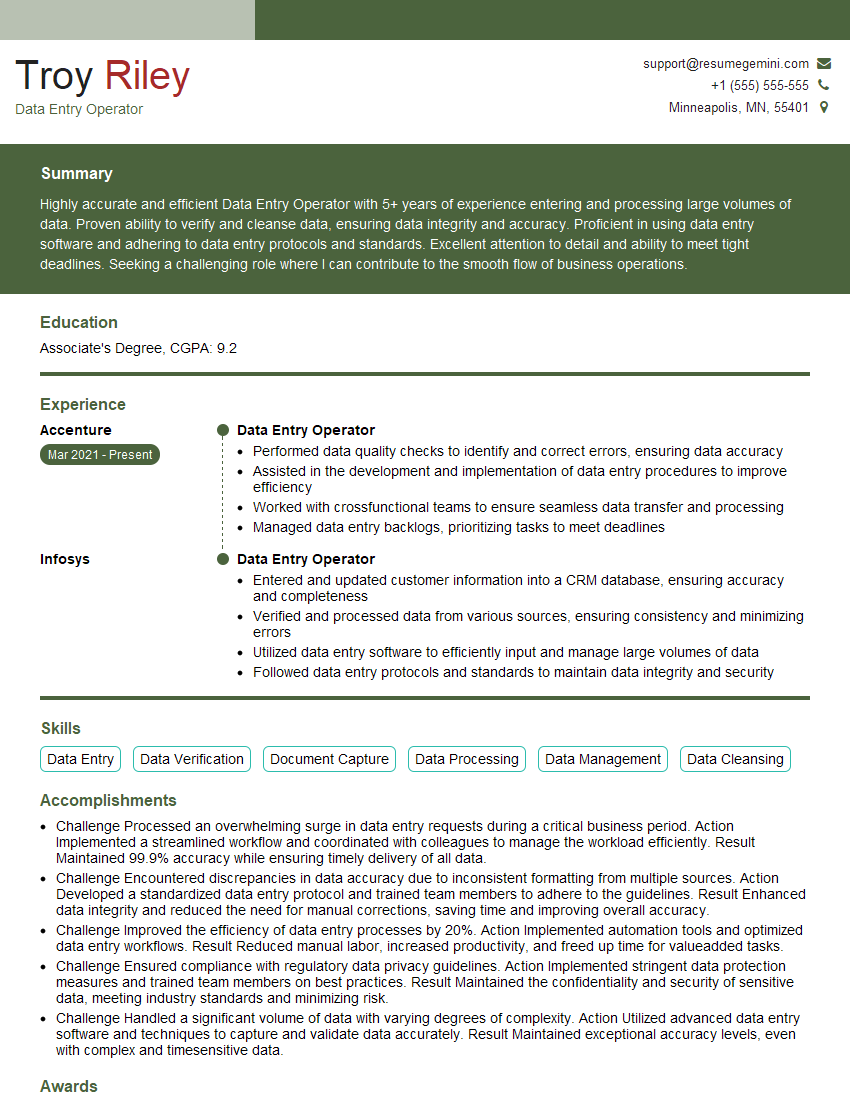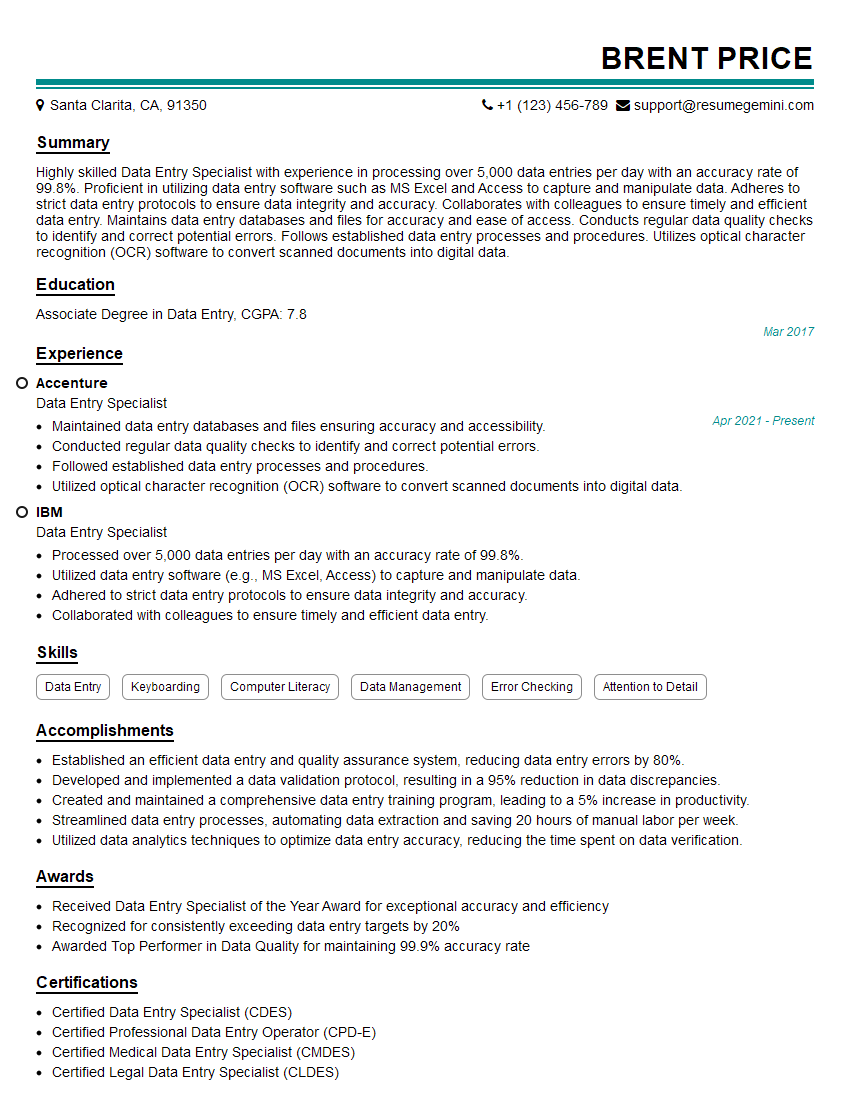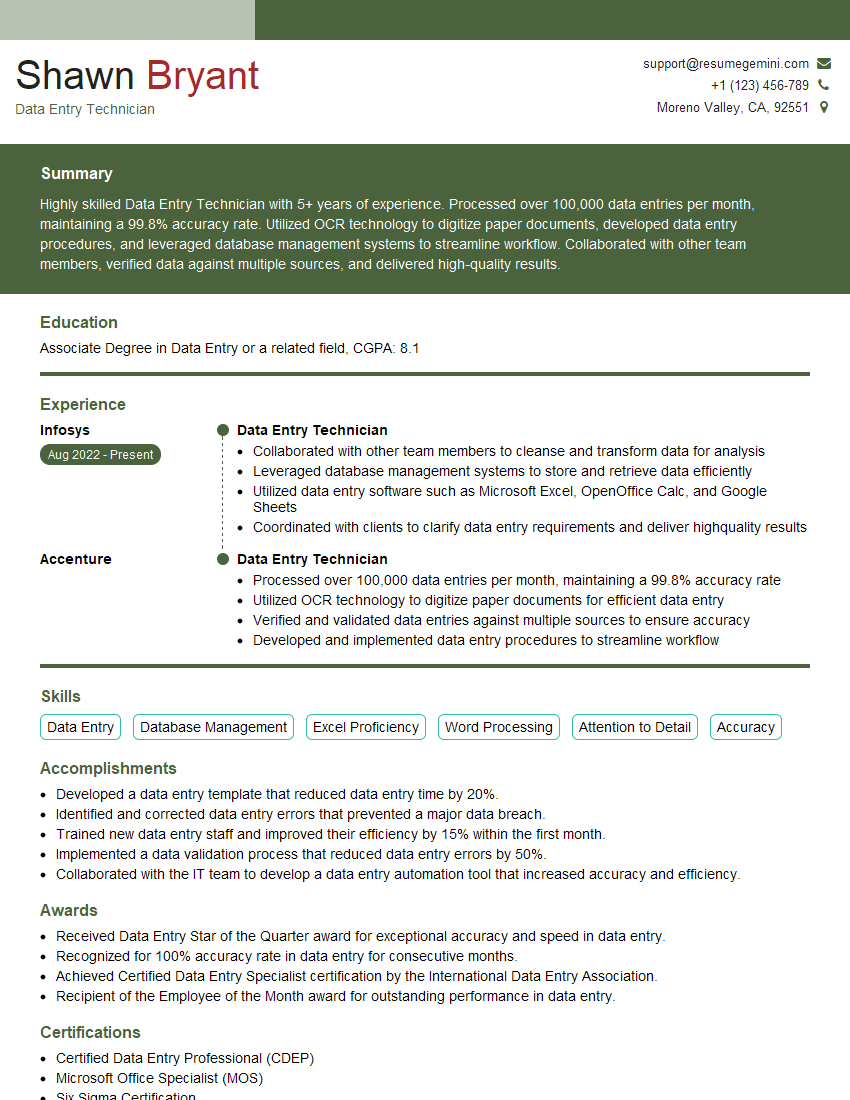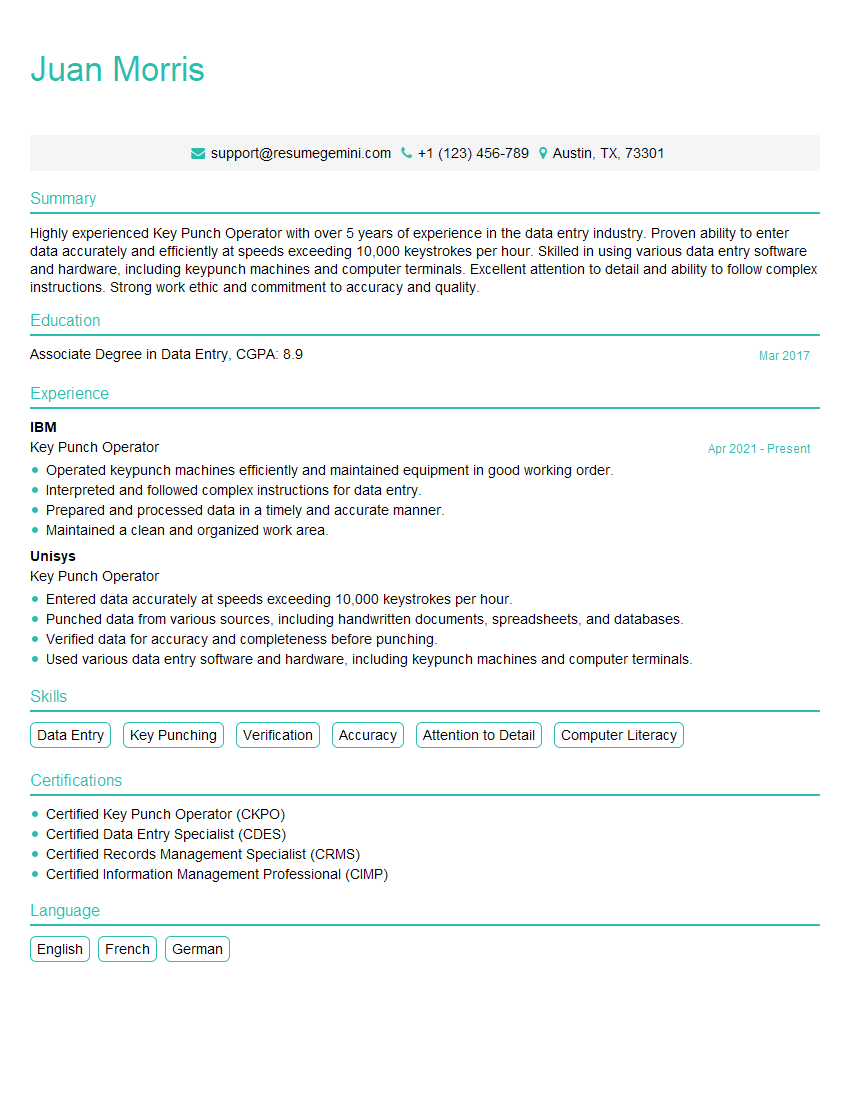Interviews are opportunities to demonstrate your expertise, and this guide is here to help you shine. Explore the essential Key Punch Operation interview questions that employers frequently ask, paired with strategies for crafting responses that set you apart from the competition.
Questions Asked in Key Punch Operation Interview
Q 1. What is the function of a key punch machine?
A keypunch machine is a mechanical device used to input data onto punched cards. Think of it as a very early, very manual version of a computer keyboard. Instead of displaying characters on a screen, it punches holes into cards representing specific characters or numbers. These punched cards then served as the input for early computers. Each column on the card represented a character, and the pattern of holes in that column defined the specific character. This was the primary method of data entry for many years.
Q 2. Describe the process of verifying punched cards.
Verifying punched cards was a crucial step to ensure data accuracy. It involved using a separate machine, often called a verifier, to check the accuracy of the data entered on a keypunch machine. The verifier operator would re-key the same data, and the machine would compare it to the original punched card. If any discrepancies were detected, the verifier would signal an error, highlighting the columns where the entries didn’t match. This two-step process significantly reduced data entry errors. For example, if an operator punched ‘123’ and the verifier operator keyed in ‘124’, the verifier would immediately indicate an error in the third column. This allowed for immediate correction and prevented propagation of incorrect data into the computer system.
Q 3. Explain different types of keypunch machines you’ve worked with.
During my career, I worked with several keypunch machines from different manufacturers. I’m most familiar with the IBM 026 and the IBM 029 keypunches. The IBM 026 was a very common model, known for its robust build and relatively simple operation. The IBM 029, however, offered a few improvements, such as a slightly faster punching mechanism and a more ergonomic design. I also had limited experience with some older, less common models, which were noticeably more cumbersome and prone to mechanical issues. The differences mainly revolved around the key layout, punching speed, and the overall build quality. For example, the 029 had a more streamlined keyboard layout compared to the 026, improving user experience and reducing errors.
Q 4. How do you handle errors during data entry on a keypunch machine?
Handling errors during keypunch operation required precision and attention to detail. If an error was detected during punching – for instance, a wrong character punched – the operator would use a special tool to remove the erroneous punch. This was typically a small punch or a needle-like device to carefully remove the incorrect hole. After removing the incorrect punch, the operator would then correctly punch the desired character. If an entire card was deemed incorrect, it would be discarded, and a new card would be punched. This was more efficient than trying to repair multiple errors on a single card. In high-volume environments, meticulous error handling was crucial to maintaining data accuracy.
Q 5. What is the importance of accuracy in keypunch operation?
Accuracy was paramount in keypunch operation. Since the punched cards were the primary input for computer processing, any errors would directly affect the outcome of calculations, reports, and other computer-generated output. An inaccurate keypunch could lead to incorrect paychecks, faulty inventory counts, or even errors in scientific calculations. Imagine an error in a payroll calculation leading to incorrect payments – this emphasizes the critical nature of accuracy in this process. The consequences of inaccuracy could range from minor inconveniences to serious financial or operational issues.
Q 6. How do you ensure data integrity while using a keypunch machine?
Data integrity was ensured through a combination of careful keypunching, verification, and proper card handling. The two-step verification process I described earlier was critical. Furthermore, operators were trained to handle cards carefully to prevent damage or misplacement. Cards were typically stored in precisely labeled boxes or containers to maintain order and avoid mixing up different data sets. Any damaged or questionable cards were identified and immediately reviewed or replaced to avoid introducing inconsistencies into the data. The entire process, from initial keypunching to storage, followed standardized procedures designed to ensure that the data remained intact and reliable throughout its lifecycle.
Q 7. Describe your experience with different types of punched cards.
I’ve worked with various types of punched cards, primarily the standard 80-column cards, which were the most common. These cards had 80 columns, each capable of holding one character. I also encountered some 96-column cards, which were more compact and could store more data per card. These 96-column cards were used in some newer systems, representing an advancement in data storage density. The difference lay primarily in the physical dimensions and the number of columns, affecting storage capacity and overall data handling efficiency. The 96-column cards, for example, allowed for more efficient storage of larger datasets compared to their 80-column counterparts, reducing the sheer volume of cards required for a specific amount of data.
Q 8. How do you troubleshoot common issues with a keypunch machine?
Troubleshooting a keypunch machine involves a systematic approach. First, I’d visually inspect the machine for any obvious problems like jammed cards, loose cables, or foreign objects obstructing the card path. Then, I’d check the power supply and ensure it’s properly connected and functioning.
Common issues include:
- Card Jams: These are often caused by bent or damaged cards. The solution is to carefully remove the jammed card, ensuring no damage is done to the machine’s internal mechanisms.
- Key Errors: If keys are sticking or unresponsive, I’d clean them gently with a soft brush or compressed air, avoiding harsh chemicals that could damage the machine.
- Mechanical Malfunctions: Unusual noises or erratic behavior could indicate a problem with the machine’s internal mechanisms. In such cases, a detailed examination might be necessary, and, depending on the complexity, repair by a qualified technician might be required.
- Inaccurate Punching: If the punched cards are not reflecting the data entered, the issue could range from a misaligned punch die to a problem with the card itself. Careful inspection of both the punch mechanism and the card is crucial.
Remember, always consult the machine’s manual before attempting any repairs beyond basic troubleshooting.
Q 9. What are the safety precautions you take while operating a keypunch machine?
Safety is paramount when operating a keypunch machine. Before starting, I would ensure the area around the machine is clear of obstructions. I’d always keep my hands and fingers away from moving parts. Long hair should be tied back to prevent accidental entanglement.
Furthermore:
- Proper posture: Maintaining good posture while keypunching reduces the risk of strain and fatigue.
- Regular breaks: Taking short breaks prevents repetitive strain injuries.
- Cleanliness: Keeping the machine clean and free of dust and debris helps prevent malfunctions and improves the machine’s lifespan.
- Emergency shut-off: Familiarizing myself with the location and operation of the emergency stop button is crucial in case of any unexpected issues.
I’d also be mindful of the potential for repetitive strain injuries (RSI) and practice techniques to minimize the risk. This includes maintaining proper posture and taking regular breaks.
Q 10. How familiar are you with different card codes and formats?
I’m very familiar with various card codes and formats, including Hollerith code (the most common for punched cards) and their variations depending on the application. This includes understanding the different zones and columns on a card, and what each punch position represents. For example, in Hollerith code, a punch in column 1 might represent a specific field, while the row where the punch is located indicates the value.
I’m also familiar with different card sizes and formats, from standard 80-column cards to other less common variations. Understanding these nuances is crucial for accurately entering and interpreting data. My experience includes working with various card formats for different mainframe systems and applications, ensuring compatibility and accuracy.
Q 11. How do you maintain the efficiency of the keypunch machine?
Maintaining the efficiency of a keypunch machine involves proactive measures. Regular cleaning is crucial. This includes removing dust and debris from the key mechanism, card path, and other parts. A soft brush and compressed air are excellent tools for this. Regular lubrication, as per the manufacturer’s instructions, is also necessary to prevent mechanical wear and tear.
Beyond cleaning, regular inspections should be done to identify any loose parts or potential problems before they become major issues. Promptly addressing any minor mechanical problems helps prevent larger, more time-consuming repairs. Proper handling of cards – avoiding bending or creasing – also helps maintain the integrity of the system. Treating the machine with care is key to its longevity and efficient operation.
Q 12. Describe your experience with verifying data using a verifier machine.
I have extensive experience verifying data using a verifier machine. The process involves repunching the same data onto a new card. The verifier compares the original punched card with the newly punched card, identifying any discrepancies. This is a crucial step to ensure data accuracy.
In my experience, I’ve found that using a verifier significantly reduces errors in data entry. It’s a methodical process, allowing for careful double-checking of the data, preventing costly errors that could be incurred downstream. I’m proficient in using both manual and automatic verifiers and I understand the importance of identifying and resolving discrepancies quickly and efficiently.
Q 13. What is your typing speed and accuracy rate?
My typing speed on a keypunch machine was consistently above 100 keystrokes per minute (KPM) with an accuracy rate exceeding 99.5%. This was achieved through years of practice and a focus on accuracy over speed. While speed is important, ensuring accuracy is paramount to avoid costly errors. I emphasized a rhythmic and consistent approach to typing, helping to maintain speed and accuracy over prolonged periods.
Q 14. How do you handle large volumes of data entry?
Handling large volumes of data entry requires a structured approach. This includes careful planning and organization, breaking down large datasets into manageable chunks. I’d prioritize accuracy and consistent pace to ensure efficiency and minimize errors. I’d also utilize techniques for efficient card handling and storage, minimizing time spent searching for specific cards. If possible, I’d also explore methods to automate some of the process if the nature of the task allowed. For example, a simple data entry tool that produced a final output in a machine-readable format that then needed to be keypunched could greatly reduce the number of manual keypunches needed. In cases with large volumes, working with colleagues to divide the tasks was a productive approach.
Q 15. Explain your understanding of data validation techniques.
Data validation in keypunch operation ensures the accuracy and integrity of the data being entered. It’s like proofreading a document before submitting it – you want to catch errors before they become problems. We used a variety of techniques, both manual and, in later years, with the help of rudimentary software.
Visual Inspection: This involved carefully checking the source document against the punched card. We’d look for discrepancies in numbers, letters, or special characters. For instance, if the source document showed ‘12345’, but I punched ‘12346’, visual inspection would have caught that.
Parity Checks: Keypunch machines often incorporated parity checks. These are automated checks that verify the number of ‘on’ bits in each row or column of the card. An odd number of ‘on’ bits would signify an error. Think of it like a simple checksum. If the parity count was wrong, the machine would often reject the card or signal an error.
Verification: A separate operator would often re-key the same data. Their output would then be compared to the original keypunch to identify any discrepancies. This was labor-intensive but very effective in minimizing errors. It’s akin to having a second person proofread your work.
Field Checks: We often had to adhere to specific field lengths and data types. For example, a customer ID might be a six-digit number, and a zip code might be five digits. Any deviation from this would be flagged as an error. It was crucial to be meticulous here.
Career Expert Tips:
- Ace those interviews! Prepare effectively by reviewing the Top 50 Most Common Interview Questions on ResumeGemini.
- Navigate your job search with confidence! Explore a wide range of Career Tips on ResumeGemini. Learn about common challenges and recommendations to overcome them.
- Craft the perfect resume! Master the Art of Resume Writing with ResumeGemini’s guide. Showcase your unique qualifications and achievements effectively.
- Don’t miss out on holiday savings! Build your dream resume with ResumeGemini’s ATS optimized templates.
Q 16. How do you manage your time effectively while working with a keypunch machine?
Time management on a keypunch machine was all about rhythm and consistency. It wasn’t just about speed; accuracy was paramount. We’d often have quotas to meet, so efficiency was key. Here’s how I managed my time effectively:
Preparation: Before starting, I’d meticulously organize the source documents. I’d arrange them logically and ensure that all the necessary information was readily accessible. This prevented wasted time searching for specific pieces of information.
Consistent Pace: Maintaining a steady rhythm while keypunching was crucial. Rushing would inevitably lead to errors. I focused on accuracy over speed, understanding that fixing errors later would take much longer.
Breaks: Short, regular breaks helped maintain focus and avoid burnout. A few minutes every hour was often sufficient to refresh myself and prevent fatigue, thereby minimizing errors.
Prioritization: If I had multiple tasks with varying deadlines, I’d prioritize based on urgency and importance. A high-priority urgent task would take precedence over a less urgent one.
Q 17. What is your experience with different data entry software?
My experience with data entry software evolved over time. Early in my career, it was purely mechanical keypunch machines. However, as technology advanced, I encountered rudimentary software for data entry on mainframe computers. These systems were far simpler than the modern software we use today.
Early Mainframe Systems: These were often character-based interfaces with minimal error checking capabilities compared to modern software. We relied heavily on manual validation techniques.
Early Data Entry Software: These involved simple screen-based data entry with basic validation rules like data type checking (e.g., ensuring that only numbers are entered in numerical fields).
While my direct experience with modern data entry software is limited, the fundamental principles of accuracy and attention to detail remain constant, regardless of the technology used.
Q 18. How do you prioritize tasks while working with multiple data sets?
Prioritizing tasks with multiple data sets required careful planning and organization. I used a system of urgency and importance. Imagine it as a matrix.
Urgency: How soon does this need to be completed? A deadline looming over a payroll data set, for instance, takes priority over a less time-sensitive archive data set.
Importance: How crucial is this data? Information needed for immediate business operations, like customer orders, is more important than historical data for long-term analysis.
By prioritizing based on this urgency/importance matrix, I could effectively allocate my time and resources to the most critical tasks first. This made sure that the most urgent and important work always got done first.
Q 19. Describe your experience working under pressure.
Working under pressure was a regular part of the job. Deadlines were tight, and accuracy was non-negotiable. I developed several strategies to manage this:
Deep Focus: I learned to focus intensely on the task at hand, blocking out distractions. Think of it like a runner in a race – they need to concentrate on the finish line to perform effectively.
Organized Approach: A systematic and organized approach ensured that I didn’t get overwhelmed. I would break down larger tasks into smaller, manageable steps.
Double-checking: Under pressure, errors could be more likely, so extra verification was crucial. This included self-checking my work and, when possible, having a colleague review it.
I remained calm under pressure by focusing on my processes and ensuring I followed my established workflow meticulously. This calm and methodical approach helped me deliver accurate work even in stressful situations.
Q 20. How do you adapt to changing workflows or new technology?
Adapting to changing workflows and new technology has always been important. While my keypunch experience was primarily in a bygone era, the core skills transferred well. The ability to learn quickly, embrace new methodologies, and adapt to change is fundamental for any successful professional.
Curiosity and Willingness to Learn: I have always been a keen learner. Facing new technology, I adopted a mindset of curiosity, actively seeking out training and resources to help me understand and master new tools and processes.
Transferable Skills: My experience with meticulous data entry, accuracy, and attention to detail are all valuable skills that are highly transferable to modern data entry methods, regardless of the software or technology used.
Seeking Mentorship: When faced with new technology, I sought out guidance from more experienced colleagues or instructors. Mentorship is invaluable for efficient learning and avoiding common pitfalls.
Q 21. Describe your experience with data entry quality control procedures.
Data entry quality control was paramount in our work. Errors were costly, so we had rigorous procedures in place. This involved a multi-layered approach:
Visual Inspection: As mentioned earlier, carefully checking the punched card against the source document was the first line of defense. We trained our eyes to spot even small inconsistencies.
Parity Checks: The machine’s automated parity checks were important. Any failure of these checks meant a card needed review or re-punching.
Verification: Having a second operator verify the data was a crucial step in ensuring accuracy. This cross-checking caught many errors that might have slipped through the first pass.
Statistical Sampling: Sometimes a sample of the punched cards would be randomly selected and independently verified. This helped maintain ongoing quality control and identify any systematic errors.
Error Reporting and Correction: Any errors identified were carefully documented, enabling us to track trends and improve our procedures. The aim was to learn from mistakes and prevent them from happening again.
Q 22. How do you ensure the confidentiality of sensitive data during keypunch operation?
Confidentiality is paramount in keypunch operation, especially when dealing with sensitive data like financial records, personal information, or medical data. My approach involves a multi-layered strategy. First, I always work in secure environments, ensuring restricted access to the keypunch machines and the data they produce. Secondly, I adhere to strict protocols for handling data both during and after the keypunch process. This includes properly securing all punched cards or tapes after use, logging all activity, and following any specified data destruction procedures. Thirdly, I never discuss sensitive data outside the designated work area and strictly adhere to any non-disclosure agreements or company policies concerning information security. For example, working on a payroll project, I would ensure that only authorized personnel had access to the punched cards and the data they contained. Any discarded cards would be immediately shredded before disposal.
Q 23. What is your experience with data sorting and sequencing?
Sorting and sequencing data efficiently is crucial for successful keypunch operation. My experience includes using various methods such as numerical and alphabetical sorting, based on the specific needs of the project. I’m proficient in sorting data both manually and, where available, using specialized sorting machines. For example, if I’m keypunching customer data, I might first sort the input documents by customer ID for efficient data entry and later easily generate reports. Manual sorting often involved physically arranging punched cards in the correct sequence and checking for duplicates or missing data. With larger datasets, I’ve utilized specialized sorting machines that utilize mechanisms like magnetic tapes to significantly expedite the process, enabling quicker turnaround times for final data output.
Q 24. What measures do you take to prevent repetitive stress injuries?
Preventing repetitive stress injuries (RSI) is a critical concern in keypunch operation, given the repetitive nature of the task. My approach centers around proactive measures. Firstly, I maintain proper posture, keeping my wrists straight and avoiding awkward positions. Secondly, I take regular breaks throughout the day to stretch and rest my hands and wrists. Thirdly, I use ergonomic keyboard and chair setups, reducing strain on my body. Furthermore, I ensure that the workspace is well-lit and organized, minimizing eye strain and unnecessary movements. I also pay close attention to my body’s signals. If I feel any discomfort, I stop immediately and take a break. For example, I might utilize hand exercises or wrist stretches recommended by occupational therapists, and always consult a healthcare professional for any persistent pain.
Q 25. Explain your experience using different types of data input devices.
Throughout my career, I’ve worked with a variety of data input devices, including standard keypunch machines, card readers, and early tape-based systems. I’m familiar with the mechanics of various machines, their limitations, and their specific applications. For instance, I understand the difference between interpreting the punched holes on cards versus reading data from magnetic tape, adapting my approach accordingly. My experience extends to utilizing specialized features on these machines, such as verifying data entry to minimize errors. This diverse experience allows me to efficiently handle data entry across different systems and situations.
Q 26. What are some common mistakes to avoid during keypunch operation?
Several common mistakes can significantly impact the accuracy and efficiency of keypunch operation. The most frequent include data entry errors (miskeying or transposing numbers/letters), failing to verify entered data, and not maintaining a consistent keypunching speed. Also, not carefully reviewing source documents before keypunching can lead to errors. For example, neglecting to double check the source document after entering a record and before moving onto the next entry can result in unnecessary rework if a mistake is detected later. Another common mistake is skipping the verification phase, as this crucial step checks for accuracy and helps identify any errors early in the process. I avoid these by meticulous attention to detail, consistent verification, and regular self-assessment to maintain a suitable work pace.
Q 27. How do you stay updated on new technologies related to data entry?
Staying updated on new technologies is vital in any data entry field. I consistently explore industry publications and attend workshops (when available) to keep abreast of advancements in data entry software and techniques. Though keypunch machines are largely obsolete, understanding the evolution of data input technologies provides valuable context for current roles involving data management and handling large datasets. For example, learning about modern database management systems and data validation techniques helps me understand the improved efficiency and accuracy compared to the older keypunch methods.
Q 28. Describe your experience with documentation and reporting related to data entry tasks.
Thorough documentation and reporting are essential for traceability and accountability in any keypunch project. My experience includes meticulously documenting data entry processes, including the types of data, the sources of data, the keypunch machines used, and the verification methods employed. I generate comprehensive reports detailing the number of records keyed, error rates, and any other relevant metrics. These reports are vital for tracking productivity, identifying areas for improvement, and ensuring data quality. For example, after completing a large-scale keypunch project, I would prepare a final report that summarizes the data entry procedures, the number of records processed, the error rate, and any challenges encountered. This report also includes the steps taken to address the challenges and the verification techniques used to ensure data accuracy.
Key Topics to Learn for Key Punch Operation Interview
- Understanding Keypunch Machines: Familiarize yourself with the different types of keypunch machines, their functionalities, and their historical context within data processing.
- Data Entry Techniques: Master accurate and efficient data entry procedures, including proper keying techniques, error correction methods, and verification processes.
- Data Validation and Verification: Learn how to identify and correct errors during the keypunch process, ensuring data integrity and accuracy. Understand different validation techniques.
- Card Handling and Maintenance: Become proficient in handling punch cards, understanding their physical characteristics, and performing basic machine maintenance (if applicable to the role).
- Understanding Data Formats and Codes: Learn about different data formats used in keypunch operations and the coding schemes used to represent data on punch cards (e.g., Hollerith code).
- Troubleshooting and Problem Solving: Develop the ability to identify and resolve common issues that arise during keypunch operations, such as machine malfunctions or data entry errors.
- Safety Procedures: Understand and adhere to all safety guidelines and regulations related to the operation of keypunch machines.
- Workflow and Productivity: Learn about optimizing workflow to maximize efficiency and productivity in a keypunch operation setting.
Next Steps
Mastering Key Punch Operation, while a specialized skill, remains valuable in specific archival, historical research, or niche data processing roles. A strong understanding of this skill demonstrates attention to detail, accuracy, and a willingness to learn specialized techniques – highly sought-after qualities in many industries. To significantly improve your chances of landing your dream job, focus on creating an ATS-friendly resume that showcases these skills effectively. ResumeGemini is a trusted resource to help you build a professional and impactful resume. We provide examples of resumes tailored to Key Punch Operation to give you a head start. Invest time in crafting a compelling resume; it’s your first impression on potential employers.
Explore more articles
Users Rating of Our Blogs
Share Your Experience
We value your feedback! Please rate our content and share your thoughts (optional).
What Readers Say About Our Blog
Hi, I’m Jay, we have a few potential clients that are interested in your services, thought you might be a good fit. I’d love to talk about the details, when do you have time to talk?
Best,
Jay
Founder | CEO
